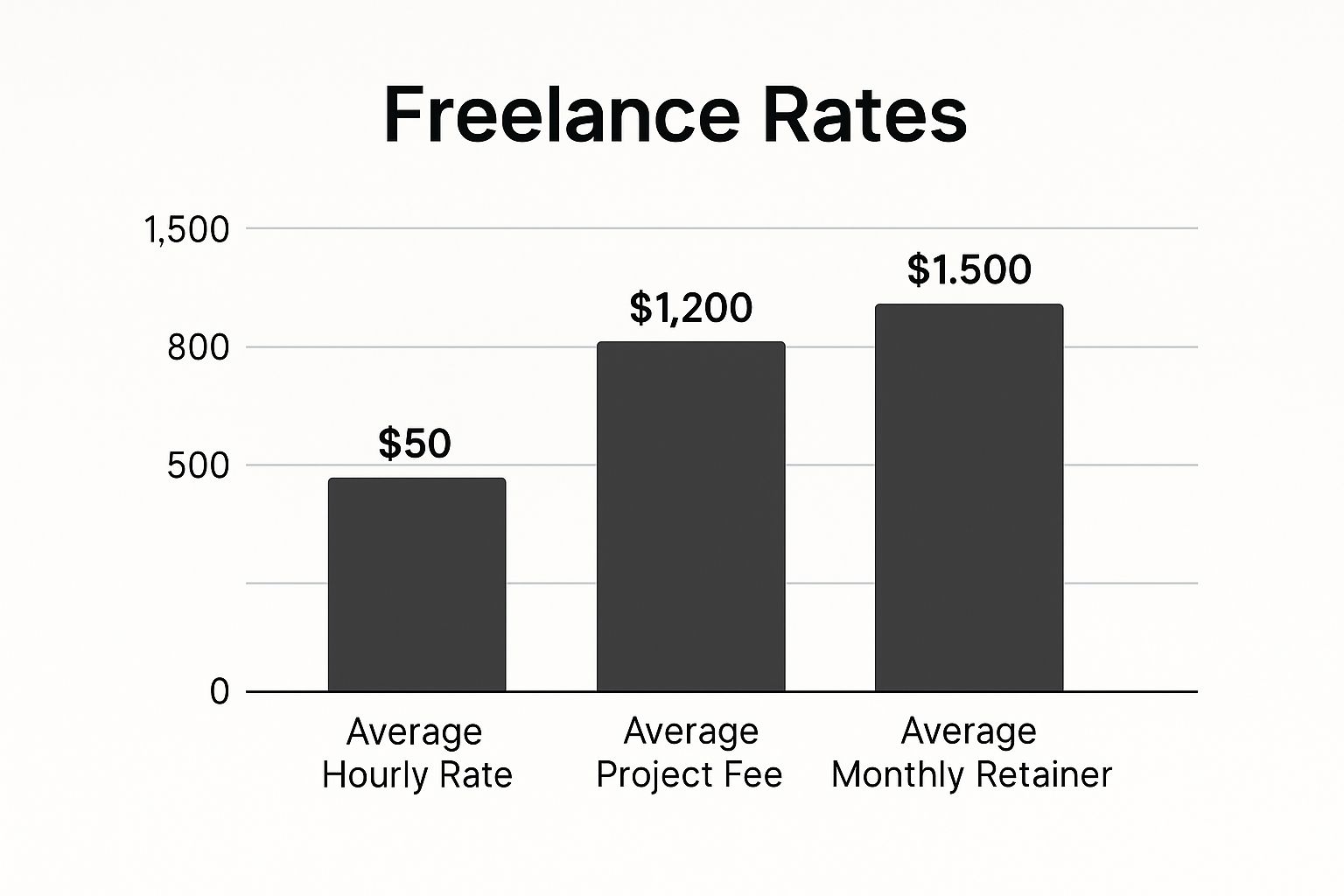Alright, let's talk about one of the first big decisions you'll make as a freelance designer: how you're actually going to charge for your work. This isn't just about picking a random number. It's about setting up a pricing model that fits your style, the kind of projects you take on, and the real value you bring to the table.
You've basically got three main flavors to choose from: hourly, project-based, and value-based. Each one has its own vibe and works best in different situations.
Choosing Your Core Pricing Model
The model you land on will completely shape your client conversations, how you define project scope, and ultimately, how much money you make. Going hourly can be a lifesaver for those wiggly projects with no clear end date, while a fixed project fee gives clients the budget certainty they crave. Then there's the big-league approach: value-based pricing, where your fee is tied directly to the business results you deliver.
This infographic gives you a quick snapshot of some typical pricing benchmarks you'll see out in the wild.

As you can see, while hourly rates are a super common starting point, designers often pull in higher total earnings with retainers and fixed-fee projects.
To help you figure out which path is right for you, let's break them down.
Here's a quick comparison of the three main pricing models to help you see the pros and cons at a glance.
Comparing Graphic Design Pricing Models
| Pricing Model | Best For | Pros for Freelancer | Cons for Freelancer |
|---|---|---|---|
| Hourly | Ongoing work, retainer clients, or projects with unclear scope. | You get paid for every minute you work, protecting you from scope creep. | Clients can get nervous about open-ended budgets, and it can cap your earning potential. |
| Project-Based | Well-defined projects with clear deliverables, like a logo package or a brochure design. | Clients love the budget certainty, and you can earn more if you work efficiently. | You have to be a master at estimating your time. One bad guess can tank your profits. |
| Value-Based | Projects with a clear, measurable impact on the client's business (e.g., increasing sales, generating leads). | Positions you as a strategic partner and offers the highest earning potential. | Requires confidence, strong negotiation skills, and the ability to prove the ROI of your work. |
Each model has its place, and you might even use a mix of them depending on the client and the project. The key is to choose intentionally.
The Hourly Rate Approach
Charging by the hour is your best friend for long-term gigs or projects where the scope feels a bit like Jell-O. Think of that client who needs you on call for social media graphics or another who has sporadic design needs throughout the month. The beauty here is that you're paid for all your time, which is the ultimate defense against endless revisions and scope creep.
Of course, this means you have to be meticulous about tracking your hours. A good time-tracking app is non-negotiable. I'd recommend checking out some of the popular freelance project management tools to find one that works for you. They make it painless to log every billable minute.
My two cents: Hourly rates are fantastic for flexibility. They ensure you’re compensated fairly for all your effort, especially on squishy projects or with retainer clients who need you on an ongoing basis.
The Project-Based Fee
This is probably the most common model you'll see for standard, well-defined design work. You quote one flat fee for the whole shebang—a logo and brand guide package, a full website mockup, you name it. Clients absolutely love this because the price is locked in. No surprises, no scary invoices.
The catch? You have to become an absolute wizard at scoping projects. You need to nail down exactly how long it will take, factoring in design time, client calls, and a few rounds of revisions. If you miscalculate, you could easily find yourself working for way less than you're worth. I've been there, and it's not fun.
The Value-Based Strategy
Welcome to the most advanced—and potentially most profitable—way to price your services. With this model, you stop trading time for money. Instead, you charge based on the tangible value your work delivers to the client's business.
Think about it: if you design a landing page that’s projected to boost their sales by $50,000 a year, a $5,000 fee doesn't just sound reasonable—it sounds like a brilliant investment for them.
This approach requires a total mindset shift. You have to move the conversation away from hours and deliverables and toward business outcomes and return on investment (ROI). Your expertise is the real product here. While hourly rates might swing from $20 for a beginner to over $150 for a seasoned pro, a value-based project can command fees of $1,000 or much more, because it's tied to results, not a clock. This model firmly positions you as a strategic partner, not just another pair of hands.
Calculating Your True Hourly Rate

Let's get real. Setting your hourly rate isn't about picking a number you think sounds good. If you're just guessing, you're setting yourself up for burnout. A profitable and sustainable freelance business is built on data, not daydreams.
It all starts with a brutally honest look at what it actually costs to run your life and your business.
Tallying Your Annual Expenses
Before you can even think about profit, you need to know exactly what your expenses are. You're a business now, and businesses have overhead. It's time to put on your CFO hat and add up everything it takes to keep the lights on for a full year.
Get granular with this. I’m talking about everything:
- Software & Subscriptions: Your Adobe Creative Cloud license is the obvious one, but don't forget project management tools, accounting software, or any other recurring payments.
- Hardware & Gear: What’s the yearly cost of your machine? If your MacBook costs $3,000 and you expect it to last three years, that’s $1,000 per year. Do the same for monitors, drawing tablets, and anything else you need to do your job.
- Business Essentials: Think website hosting, domain fees, professional insurance (don't skip this!), and any fees for accountants or lawyers.
- Marketing & Education: This bucket includes your portfolio hosting, any ad spend, and—crucially—courses or workshops to keep your skills from getting stale.
Once you have that total, do the same thing for your personal life. Add up your rent or mortgage, utilities, groceries, healthcare, and everything else you need to live comfortably.
Combine your business and personal expenses. That’s your baseline number—the absolute minimum you need to earn just to break even.
Key Takeaway: Your rate isn't just for your design time. It’s for the entire professional ecosystem you’ve built—from the software you use to the roof over your head.
Factoring in Profit and Non-Billable Time
Okay, breaking even is for hobbies. We're building a business. To actually grow, you need to factor in a profit margin. A healthy target is to add a 20-30% profit margin right on top of your total annual costs. This is your fund for savings, reinvesting in better gear, and handling those "oops" moments that always pop up.
So, if your total annual expenses are $60,000, a 25% profit margin ($15,000) means your new target annual income is $75,000. See? Now we're talking.
But there's one more crucial piece of the puzzle: time you can't bill for.
Freelancing is not 100% design work. Not even close. You'll spend a huge chunk of your week—often 30-40%—on things like marketing, answering emails, chasing invoices, and finding new clients.
Let's do the math. A standard work year has about 2,080 hours (40 hours/week x 52 weeks). But after you account for all that non-billable admin work, plus vacations and sick days, a realistic freelancer might only have around 1,200 billable hours.
Now, the final calculation is beautifully simple:
Target Annual Income ÷ Total Billable Hours = Your Baseline Hourly Rate
Using our running example: $75,000 ÷ 1,200 hours = $62.50 per hour.
This $62.50 isn't just a random number. It's your true rate, backed by your own data. It's the number that ensures your business is sustainable. While platforms like Upwork might show a $15-$35 per hour range for intermediate designers, this formula ensures your specific needs are met. For a broader look at industry pay, you can explore graphic designer rates for 2025.
How to Scope Projects for Profit
Project-based pricing feels great, right? It offers stability for you and your client. But that stability lives or dies on one thing: how well you scope the project. Honestly, this is what separates the profitable gigs from the ones that leave you broke and burned out. It all starts way before you even think about opening Illustrator.
The whole process kicks off with the discovery call. This isn’t just a friendly chat; you need to be a strategic investigator. Your mission is to gently pull the client's complete vision out of them, not just the surface-level stuff they think they need. Ask probing questions to get to the real business goal behind the pretty picture they're asking for.
Defining Deliverables and Timelines
Once you get the "why," you can start breaking down the "what." A vague request like, "I need a new brand identity," has to be turned into a structured, multi-phase plan. I think of it like building a house—you don't put up the walls before you've poured the foundation.
For that brand identity project, the breakdown might look something like this:
- Phase 1: Discovery & Strategy: This covers our initial call, market research, pulling together mood boards, and presenting the overall strategy.
- Phase 2: Concept Development: This is where the magic happens. I'll create and present 2-3 distinct logo concepts.
- Phase 3: Refinement & Build-out: We’ll dial in the chosen concept with revisions and then create all the other pieces—the color palette, typography system, and so on.
- Phase 4: Final Delivery: I’ll package up all the final files and hand over a comprehensive brand guidelines PDF.
For every single phase, you have to estimate the hours. Be honest with yourself and lean on past experience. If a similar logo concept took you 15 hours last time, that's your baseline. Then, just multiply those hours by that true hourly rate you already worked out.
Here's a classic mistake I see all the time: freelancers totally underestimating revisions. You have to build a buffer into your timeline and your budget. I always recommend adding 15-20% to your total estimated hours. It’s a lifesaver for handling client feedback and those little surprises that always pop up.
Protecting Your Profitability
With your phases mapped out and your hours buffered, you can set a fixed project fee with total confidence. This is your shield against scope creep, which is an absolute profit-killer. For a much deeper look at this, our guide on controlling project scope has some killer advanced tactics.
As a final check, use a profit margin calculator to make sure the numbers actually work. This confirms your fee doesn't just cover your time and costs but actually helps your business grow. When you present this kind of data-backed proposal, it gives the client clarity and, most importantly, protects your bottom line.
Earning More With Value-Based Pricing

Alright, let's talk about the big one. If you're tired of trading your time for money and you've gotten pretty good at scoping projects, it's time to level up. I'm talking about value-based pricing.
This is where the game completely changes. You stop answering, "How many hours will this take?" and you start asking, "What kind of business result are we trying to create?"
It's a huge mental shift. You're no longer just a designer they hire to complete a task; you become a strategic partner they invest in. Your fee stops being a line-item expense and turns into a direct investment in their company's future. It's powerful stuff.
Asking The Right Questions
To pull this off, you have to completely reframe your discovery calls. You're not just a passive order-taker anymore—you're a detective looking for the real business problem. Your mission is to dig for the metrics that show how much your work could be worth.
You need to get comfortable asking direct, money-focused questions. Think along these lines:
- "What's the current monthly revenue this sales page is bringing in?"
- "Roughly how much is a new lead worth to you?"
- "If we redesigned this page and bumped your conversion rate by just 2%, what would that look like in new revenue?"
- "What's the lifetime value of a customer who comes through this funnel?"
The answers to these questions are gold. They give you the concrete data you need to anchor your price to tangible, real-world value. Nailing this part of the conversation is a hallmark of a professional freelance business and shows the client you're thinking about their bottom line, not just pretty pictures.
Proposing Your Value-Based Fee
Once you have that information, you can build your proposal with a ton of confidence.
Let's say a client's landing page is currently pulling in $200,000 a year. Through your discovery process, you've identified clear opportunities to improve it. You genuinely believe your redesign could increase their conversions by 50%, which would mean an extra $100,000 in their pocket.
With that context, a $10,000 project fee isn't an "expensive design." It’s an investment with a potential 10x return. Suddenly, your price looks like an absolute steal.
This is the mindset that separates the six-figure freelancers from everyone else. You have to start thinking bigger and have the confidence to go after those high-impact projects. Learning from designers who know how to secure a 10K opportunity on Upwork can give you the roadmap to pitching and landing this kind of work.
Ultimately, value-based pricing is your ticket to smashing your income goals and becoming a truly irreplaceable partner to your clients.
Communicating Your Value and Handling Negotiations

Alright, you've crunched the numbers and figured out your rates. That’s a huge step. But here’s the thing: setting your prices is only half the battle. The real magic happens when you learn to communicate them effectively. This is what separates struggling freelancers from the ones who seal the deal with confidence.
When you present your proposal, you're not just handing over a number. You’re showcasing your skill, your experience, and the very real, strategic value you’re about to bring to a client’s business. Think of it as an investment pitch, not a price tag.
So, how do you do that? Instead of just sending a dry list of deliverables, connect every single item to a tangible benefit for your client. Show them how a professionally designed logo will boost their brand recognition, or how amazing marketing materials are essential for scaling client results with smart social media strategy. It completely reframes the conversation around shared success.
Navigating Budget Objections
It’s going to happen. Sooner or later, a potential client will hit you with the classic: "That’s a bit more than we were hoping to spend." It’s easy to panic and immediately offer a discount, but that's a quick way to devalue your work. The goal is to hold your ground while still finding a way to move forward together.
The trick is to adjust the project's scope, not your rate.
Try saying something like this: "I totally understand your budget constraints. To get us closer to your number, we could simplify the branding package. How about we focus on the core logo concept and color palette for now, and hold off on the extended social media templates? Would that work for you?"
This approach is a game-changer. It keeps the integrity of your pricing intact while showing you're flexible and willing to collaborate. You're also subtly teaching the client that your time and expertise have a fixed, professional value.
Mastering this kind of negotiation is a cornerstone of strong client communication best practices and is absolutely critical for building a respected freelance brand.
Justifying Your Rates with Confidence
Your experience level is directly tied to what you can earn, and it’s the bedrock for justifying your prices. Let's look at the numbers.
- Entry-level designers often start out earning between $25,000 and $45,000 annually.
- Mid-level freelancers with a few years under their belt can command $45,000 to $75,000.
- Seasoned designers with a strong portfolio regularly earn between $75,000 and $120,000.
- Top-tier specialists in fields like UX/UI can easily clear $200,000.
When you know exactly where you fit in the market, you can talk about your value with genuine confidence. Stand firm on your prices, be ready to explain the "why" behind your fee, and focus your energy on attracting clients who see your expertise not as a cost, but as the solution they’ve been searching for.
Common Freelance Pricing Questions Answered
Let's be honest—navigating the money side of freelance graphic design can feel like walking through a minefield. You're constantly trying to balance being profitable with keeping clients happy. It’s tricky, but getting a handle on a few recurring questions can make all the difference.
Let's dive into some of the biggest pricing headaches freelancers run into and how to solve them.
Should I List My Prices on My Website?
This is the classic debate, and there’s no one-size-fits-all answer. It really depends on who you're trying to attract.
Putting your prices out there, especially for standardized services like a basic logo package, is a fantastic filter. It instantly weeds out prospects whose budgets are nowhere near your ballpark, saving you a ton of time on dead-end discovery calls.
But—and this is a big but—listing fixed prices can sometimes scare off bigger corporate clients. They often have complex, high-value projects that don't fit into a neat little box. They might see a price tag and bounce before you ever get a chance to talk strategy and show them the real value you bring.
A hybrid approach is often the sweet spot. Try listing "starting at" prices. This gives smaller clients the budget clarity they crave while leaving the door open for you to prepare a custom quote for those larger, more involved projects.
Key Insight: This strategy offers the best of both worlds. You get the transparency that builds trust while maintaining the flexibility to price custom work based on its actual scope and impact.
How Do I Handle Requests for Discounts?
When a client asks for a discount, it's easy to feel cornered. Your first instinct might be to just say yes to keep them happy, but that’s a quick way to devalue your work and your time.
Instead of slashing your rate, politely offer to reduce the project's scope. This simple pivot changes the entire conversation. It’s no longer about you being cheaper; it’s about working together to fit their budget.
You could say something like, "I can definitely work within that budget. To make it happen, we could focus on the primary logo concept and color palette, and hold off on the social media templates for now." This keeps your pricing logic intact and reinforces that your fees are tied directly to the work you deliver.
And for those "can you work for exposure?" requests? A polite but firm "no" is all you need. Explain that you focus on paid projects to ensure every client gets your best, most dedicated work.
When Should I Raise My Graphic Design Prices?
You should be looking at your rates at least once a year. Raising your prices isn't greedy; it's a sign that your business is healthy and growing. It shows you're getting better, more experienced, and delivering more value.
So, when's the right time? Look for these triggers:
- You're booked solid: If your calendar is consistently full, demand for your skills has officially outgrown your current pricing. It's Economics 101.
- Your portfolio just got a glow-up: Did you just wrap up a huge, impressive project for a well-known brand? That instantly boosts your perceived value.
- You've learned new skills: Picked up a high-demand skill like motion graphics or UX/UI design? That expertise is worth more.
- Rave reviews are rolling in: Powerful testimonials and case studies are concrete proof of the incredible results you deliver.
When you decide to pull the trigger, give your existing clients a heads-up. Let them know your rates are changing to reflect your professional growth. As a nice gesture, you could even offer them one last project at your old rate.
How Do I Prevent Scope Creep in Projects?
Scope creep—those little "can you just…" requests—can absolutely destroy your profitability and your sanity. Your best defense? A rock-solid, incredibly detailed contract. This document isn't just a formality; it's your most important tool.
If you need a starting point, checking out a comprehensive freelancer contract template can help make sure you’ve got all your bases covered.
Your agreement needs to be crystal clear. Define every single deliverable. Specify the exact number of revision rounds included (e.g., two full rounds of revisions). And clearly state what counts as a "revision" versus what is a brand-new request.
Most importantly, include a clause that says any work requested outside the original scope will be quoted and billed as a separate item. When a client inevitably asks for "just one more little thing," you can professionally point back to the agreement and send over a quick quote for the additional work. No hard feelings, just good business.
Ready to connect with clients who value your creative expertise? Creativize is the platform where talented designers find businesses ready to invest in high-quality work. Join our community today and start building a more profitable freelance business.

